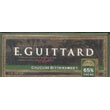FLAVOR PROFILE: mainly FRUIT (soft intensity reds – especially cherry cordial) & an air-pocket of fleeting FLOWERS (honeysuckle rose, jasmine, chrysanthemum) + that famed marshmallow; sometimes honey, nuts & spices
CHARACTERISTICS: hybrids largely replacing the antigo real (‘ancient royal’) relics of Criollo; nonetheless this “soft terra” produces overall delicate cacáo, gently astringent / acidic despite an ominous marker creeping into the crop: cadmium
Chocolate made from Colombian cacáo often resonates seraphic enchantment, varying notes of honey, blossoms, & marshmallows.
Prior to 1784, a demarcation point when the town of San Faustino at the center of the country’s cacáo trade was destroyed by an earthquake, Colombian cacáo equaled Venezuela’s because it basically was just that – located at the western extension of the great cacáo stretch from the foothills of the Venezuelan Andes. A variant of Criollo on the Santa Marta massif was named ‘Mountain Cacao’ but interest in it inexplicably waned & the variety was left to itself.
The antigo real (‘ancient royal’) relics of Criollo from San Faustino are rare today, having been mixed in with the ubiquitous Pajarito, an Amazonian likely brought over from the Caribbean around 1890, later mixed to form the hybrid Caucano. Since then the scene has also shifted to the valleys of Santander around San Vincente de Chucuri stretching to Santa Marta on the northern coast.
At the southern end of the country, there’s the flavorful Esmeraldas on the border with Ecuador. Inland along the banks of the Rio Caquetá running toward the Amazon & Brazil are native cacáo woods of a single variety. In between, sporadic pockets include ‘Colombian Nacionals’ which supposedly share properties with Ecuador’s Nacional.
To capitalize on the growing demand for chocolate worldwide, the Colombian Government in conjunction with Fedecacao (the national association of cacáo growers) has embarked on an ambitious ‘Plan Decenal’ (10-Year Plan) to increase production of cacáo from 40,000 tons to 250,000 tons by the year 2020. Expect ever more in the way of hybrids & clones.
Colombia also forms a historical & cultural bridge via the Panamanian isthmus to Mesoamerica: both indigenous cultures prepared cacáo in a similar libation – yet another reason for its inclusion in the Caribia region.
As a general rule, however, the northeastern boundary of Colombia’s Chocó (seriously, no kidding) Province draws a dividing line between ethno-botanical cacáo usage in the Americas. Above the line, ancient peoples mostly prepared a beverage from cacáo seeds; below it, they made drinks with the pulp surrounding the seeds.
 Chocó Province (in red)
Chocó Province (in red)





